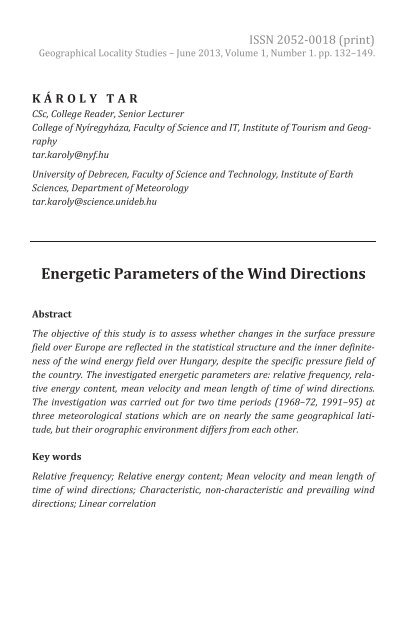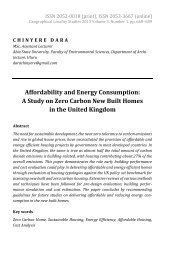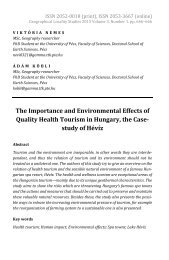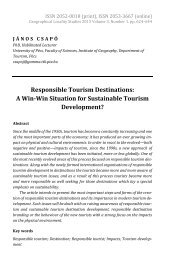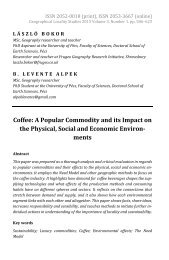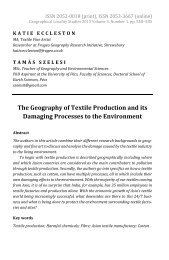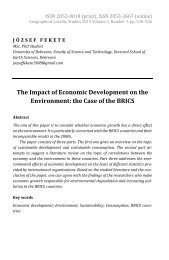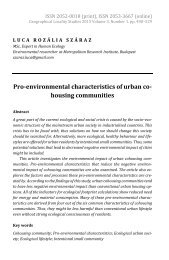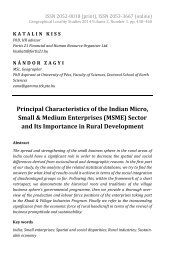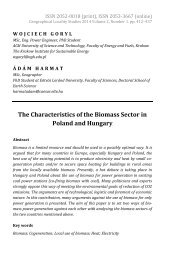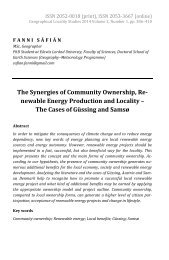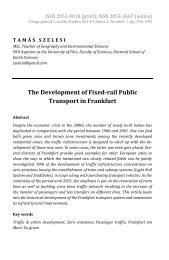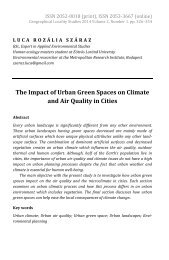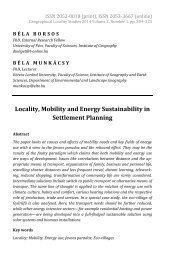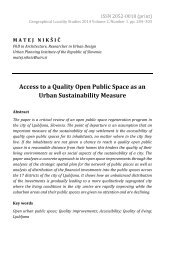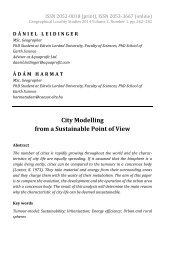Károly Tar: Energetic Parameters of the Wind Directions
The objective of this study is to assess whether changes in the surface pressure field over Europe are reflected in the statistical structure and the inner definiteness of the wind energy (relative frequency, relative energy content, mean velocity, etc.) field over Hungary, despite the country’s specific pressure field.
The objective of this study is to assess whether changes in the surface pressure field over Europe are reflected in the statistical structure and the inner definiteness of the wind energy (relative frequency, relative energy content, mean velocity, etc.) field over Hungary, despite the country’s specific pressure field.
You also want an ePaper? Increase the reach of your titles
YUMPU automatically turns print PDFs into web optimized ePapers that Google loves.
ISSN 2052-0018 (print)<br />
Geographical Locality Studies – June 2013, Volume 1, Number 1. pp. 132–149.<br />
K Á R O L Y T A R<br />
CSc, College Reader, Senior Lecturer<br />
College <strong>of</strong> Nyíregyháza, Faculty <strong>of</strong> Science and IT, Institute <strong>of</strong> Tourism and Geography<br />
tar.karoly@nyf.hu<br />
University <strong>of</strong> Debrecen, Faculty <strong>of</strong> Science and Technology, Institute <strong>of</strong> Earth<br />
Sciences, Department <strong>of</strong> Meteorology<br />
tar.karoly@science.unideb.hu<br />
<strong>Energetic</strong> <strong>Parameters</strong> <strong>of</strong> <strong>the</strong> <strong>Wind</strong> <strong>Directions</strong><br />
Abstract<br />
The objective <strong>of</strong> this study is to assess whe<strong>the</strong>r changes in <strong>the</strong> surface pressure<br />
field over Europe are reflected in <strong>the</strong> statistical structure and <strong>the</strong> inner definiteness<br />
<strong>of</strong> <strong>the</strong> wind energy field over Hungary, despite <strong>the</strong> specific pressure field <strong>of</strong><br />
<strong>the</strong> country. The investigated energetic parameters are: relative frequency, relative<br />
energy content, mean velocity and mean length <strong>of</strong> time <strong>of</strong> wind directions.<br />
The investigation was carried out for two time periods (1968–72, 1991–95) at<br />
three meteorological stations which are on nearly <strong>the</strong> same geographical latitude,<br />
but <strong>the</strong>ir orographic environment differs from each o<strong>the</strong>r.<br />
Key words<br />
Relative frequency; Relative energy content; Mean velocity and mean length <strong>of</strong><br />
time <strong>of</strong> wind directions; Characteristic, non-characteristic and prevailing wind<br />
directions; Linear correlation
Introduction<br />
Geographical Locality Studies 2013 Volume 1, Number 1<br />
The rise in global surface air temperature, due to <strong>the</strong> increase <strong>of</strong> <strong>the</strong><br />
atmospheric concentration <strong>of</strong> greenhouse gases, has probably induced<br />
a redistribution <strong>of</strong> <strong>the</strong> surface pressure field. According to SCHÖNWIESE,<br />
C. D. et al. (1994) and MEYHÖFER, S. et al. (1996), this process has occurred<br />
in Europe: in <strong>the</strong> winter half-year, <strong>the</strong> average values <strong>of</strong> surface<br />
pressure, converted to sea level, increased in <strong>the</strong> south and decreased<br />
in <strong>the</strong> north <strong>of</strong> <strong>the</strong> continent between 1961 and 1990. In <strong>the</strong> summer<br />
half-year, however, <strong>the</strong>re were no significant changes. On <strong>the</strong> o<strong>the</strong>r<br />
hand, METAXAS, D. A. et al. (1991) and BARTZOKAS, A. – METAXAS, D. A.<br />
(1996) found that <strong>the</strong> average intensity <strong>of</strong> influx <strong>of</strong> cold air masses in<br />
summer, coming from <strong>the</strong> north and northwest to <strong>the</strong> sou<strong>the</strong>ast <strong>of</strong><br />
Europe, had increased. Therefore, according to <strong>the</strong>ir investigations, <strong>the</strong><br />
summer circulation system is also changing, as a consequence <strong>of</strong> <strong>the</strong><br />
redistribution <strong>of</strong> <strong>the</strong> surface pressure field in summer, as well.<br />
The spatial distribution <strong>of</strong> annual and monthly average sea level<br />
pressure fields in Hungary is due to <strong>the</strong> so called "basin character".<br />
Roughly in <strong>the</strong> middle <strong>of</strong> <strong>the</strong> Great Hungarian Plain, a pressure minimum<br />
can be found. This is caused by strong warming in summer and<br />
<strong>the</strong> frequent passing through <strong>of</strong> <strong>the</strong> Mediterranean cyclones in winter<br />
(DOBOSI, Z. – FELMÉRY, L. 1971). The aim <strong>of</strong> <strong>the</strong> former investigations<br />
(TAR, K. 1998a, 1998b, 1999, 2001; MIKA, J. et al. 1999; TAR, K. et al.<br />
2000, 2001; MAKRA, L. et al. 2000a, 2000b) was to decide whe<strong>the</strong>r or<br />
not <strong>the</strong> observed changes in <strong>the</strong> pressure field over Europe could be<br />
detected in <strong>the</strong> statistical structure <strong>of</strong> <strong>the</strong> wind field over Hungary,<br />
despite <strong>the</strong> specific pressure field over <strong>the</strong> country.<br />
In this paper, <strong>the</strong> useful properties <strong>of</strong> some energetic parameters <strong>of</strong><br />
wind directions and <strong>the</strong> change in time and space <strong>of</strong> stochastic relationship<br />
between <strong>the</strong>se parameters are analysed.<br />
1. Database and research methods<br />
The database consists <strong>of</strong> hourly wind direction data and wind velocities<br />
<strong>of</strong> three meteorological stations—Debrecen, Budapest and Szomba<strong>the</strong>ly—between<br />
<strong>the</strong> periods <strong>of</strong> 1968–72 and 1991–95 measured at<br />
133
<strong>Károly</strong> <strong>Tar</strong><br />
10 meters. These stations are about on <strong>the</strong> same geographical latitude,<br />
but <strong>the</strong>ir orographic environment differs from each o<strong>the</strong>r (Figure 1).<br />
Figure 1 – Locations <strong>of</strong> <strong>the</strong> meteorological stations in Szomba<strong>the</strong>ly, Budapest<br />
and Debrecen<br />
Edited by SZELESI, T. (2013)<br />
The investigation was carried out for <strong>the</strong> two complete periods and<br />
for <strong>the</strong> subsets <strong>of</strong> those. The subsets were produced by two methods:<br />
(1.) by <strong>the</strong> differentiation <strong>of</strong> natural seasons and (2.) by defining <strong>the</strong><br />
macrosynoptic-type groups from György Péczely’s macrosynoptictypes.<br />
As opposed to PÉCZELY, GY. (1983), <strong>the</strong> central type is handled<br />
separately on <strong>the</strong> base <strong>of</strong> its obviously different air flow characteristics.<br />
According to this, <strong>the</strong> following categories and centres are used:<br />
Meridional Nor<strong>the</strong>rn (MN), Meridional Sou<strong>the</strong>rn (MS), Zonal Western<br />
(ZW), Zonal Eastern (ZE) type groups and anticyclone centre (A) and<br />
cyclone centre (C) types. The base <strong>of</strong> <strong>the</strong> classification is <strong>the</strong> place <strong>of</strong><br />
<strong>the</strong> cyclone or anticyclone centres relative to Hungary. The types that<br />
govern <strong>the</strong> wea<strong>the</strong>r <strong>of</strong> Hungary can be grouped in as cyclonal type<br />
134
Geographical Locality Studies 2013 Volume 1, Number 1<br />
group (CG). Anticyclonal type group (AG) can be defined similarly. For<br />
<strong>the</strong> classification <strong>of</strong> <strong>the</strong> individual days, <strong>the</strong> macrosynoptic codes <strong>of</strong><br />
PÉCZELY, GY. (1983) and KÁROSSY, CS. (1998) have been used. The sizes<br />
(<strong>the</strong> length <strong>of</strong> days) <strong>of</strong> <strong>the</strong> macrosynoptic-types/type groups for <strong>the</strong><br />
two five-year-long periods are shown in Table 1.<br />
Table 1 – The number <strong>of</strong> days <strong>of</strong> <strong>the</strong> various type groups (days) and <strong>the</strong>ir<br />
length relative to <strong>the</strong> whole length <strong>of</strong> <strong>the</strong> period (%) in <strong>the</strong> two complete 5-<br />
year-periods<br />
1968–72 1991–1995<br />
days % days %<br />
MN 301 16.5 401 22.0<br />
MS 529 32.4 434 23.8<br />
ZW 429 23.5 390 21.4<br />
ZE 348 19.1 235 12.9<br />
A 134 7.3 269 14.7<br />
C 22 1.2 97 5.2<br />
1826 100.0 1826 100.0<br />
AG 1187 65.0 1259 68.9<br />
CG 639 35.0 567 31.1<br />
1826 100.0 1826 100.0<br />
It is evident that <strong>the</strong> difference between <strong>the</strong> number <strong>of</strong> days <strong>of</strong> <strong>the</strong><br />
type A is about two times larger than that <strong>of</strong> <strong>the</strong> type C, and <strong>the</strong> frequency<br />
<strong>of</strong> <strong>the</strong> days in <strong>the</strong> AG-type group is higher by 4 per cent in <strong>the</strong><br />
second period. Based on this, we can conclude that <strong>the</strong> wind velocity<br />
and wind energy in this period decreased. Stagnation or a small increase<br />
occurs in a few cases only in Debrecen (winter, ZE, A). The largest<br />
decrease is in Szomba<strong>the</strong>ly: in <strong>the</strong> MN, MS, ZE and CG-type groups<br />
and in type C, <strong>the</strong> decrease is above 1 m/s. The spatial average <strong>of</strong> <strong>the</strong><br />
decrease is <strong>the</strong> largest in <strong>the</strong> type C, and <strong>the</strong>n <strong>the</strong> MN, MS and <strong>the</strong> CGtype<br />
groups follow.<br />
2. <strong>Energetic</strong> statistics <strong>of</strong> <strong>the</strong> wind direction<br />
In <strong>the</strong> following, <strong>the</strong> relationship among relative frequency (%), relative<br />
energy content (%), average velocity (m/s) and <strong>the</strong> average length<br />
135
<strong>Károly</strong> <strong>Tar</strong><br />
<strong>of</strong> time <strong>of</strong> <strong>the</strong> wind directions are going to be investigated. The relative<br />
energy content <strong>of</strong> a D wind direction for a sub-period (season, type,<br />
type group) can be determined by <strong>the</strong> mean specific wind power,<br />
namely with <strong>the</strong> equation,<br />
P<br />
k<br />
Dj 3<br />
f1( D)<br />
vj<br />
2 j1<br />
N<br />
f<br />
.<br />
where f Dj is <strong>the</strong> frequency <strong>of</strong> <strong>the</strong> speed <strong>of</strong> <strong>the</strong> D wind within <strong>the</strong> (v j -<br />
0.5v, v j +0.5v) interval, k is <strong>the</strong> number <strong>of</strong> intervals and N is <strong>the</strong><br />
number <strong>of</strong> days <strong>of</strong> <strong>the</strong> time period, respectively. If P f1 , denoting <strong>the</strong><br />
mean specific wind power <strong>of</strong> time period, is independent <strong>of</strong> <strong>the</strong> wind<br />
directions <strong>the</strong>n <strong>the</strong> ratio<br />
P<br />
p(<br />
D)<br />
<br />
P<br />
f1 ( D)<br />
f1<br />
is equal to <strong>the</strong> relative energy content <strong>of</strong> <strong>the</strong> given D wind direction.<br />
The average velocity <strong>of</strong> this direction is:<br />
v(D)<br />
k fDj<br />
v<br />
j1N<br />
The value <strong>of</strong> <strong>the</strong> last parameter strongly depends on <strong>the</strong> height <strong>of</strong><br />
<strong>the</strong> anemometer. This height is regularly 10 metres in <strong>the</strong> meteorological<br />
stations, but <strong>the</strong> measure <strong>of</strong> <strong>the</strong> wind speed can happen on lower<br />
or higher levels. In <strong>the</strong>se cases, <strong>the</strong> height correction is achieved by <strong>the</strong><br />
following equation:<br />
v h 10 [0.233+0.656lg(h+4.75)]<br />
where v h is <strong>the</strong> measured wind speed on h10 m and v 10 is <strong>the</strong> calculated<br />
wind speed on 10 m. The average length <strong>of</strong> time <strong>of</strong> <strong>the</strong> wind directions<br />
can be determined by <strong>the</strong> distribution <strong>of</strong> hours with <strong>the</strong> same<br />
wind direction (M, M. – SIMON, A. 1981).<br />
136<br />
j
Geographical Locality Studies 2013 Volume 1, Number 1<br />
3. Characteristic and non-characteristic wind directions<br />
In this and <strong>the</strong> following subdivisions, <strong>the</strong> relationship between <strong>the</strong><br />
relative frequency and <strong>the</strong> relative energy content <strong>of</strong> wind directions<br />
in a special case will be investigated.<br />
To decide which are <strong>the</strong> wind directions with significant definite<br />
frequency—i.e. it is not random that <strong>the</strong>y are present in a given place<br />
at a given time— <strong>the</strong> statistical test for hypo<strong>the</strong>sis <strong>of</strong> probability evenness<br />
has been used (VINCZE, I. 1975). This can be applied to <strong>the</strong> problem<br />
as it follows: in a given probability level, we can determine a<br />
critical interval with h 1 and h 2 >h 1 borders. If <strong>the</strong>re is, at least, one D<br />
wind direction with f D frequency, so that f D >h 2 , we cannot consider <strong>the</strong><br />
distribution <strong>of</strong> <strong>the</strong> wind direction to be even. In this case, D is called a<br />
characteristic wind direction (CWD), o<strong>the</strong>rwise, it is a noncharacteristic<br />
wind direction (NWD) on 1- probability level (TAR, K.<br />
1991a, 1991b). The values <strong>of</strong> h 1 and h 2 are (VINCZE, I. 1975):<br />
h1 p0nu<br />
np0(1p0)<br />
h2 p0nu<br />
np0(1p0)<br />
where p 0 is equal to 1 0. 0625 , as we used 16 wind directions, n is<br />
16<br />
<strong>the</strong> number <strong>of</strong> cases (24*number <strong>of</strong> days), u satisfies <strong>the</strong> equation<br />
2(<br />
u)<br />
11<br />
where (x) is <strong>the</strong> distribution function <strong>of</strong> <strong>the</strong> standard normal distribution.<br />
Let be PÉCZELY, GY. (1957)<br />
for <strong>the</strong> efficiency <strong>of</strong> <strong>the</strong> test. In this case u <br />
If f D is given in %, <strong>the</strong>n <strong>the</strong> limits <strong>of</strong> <strong>the</strong> critical interval are<br />
H 1 1 /n, H 2 2 /n. The value <strong>of</strong> H 2 changes between 6.6 (whole<br />
period) and 9.4 (type C in period 1968–72), so we can say, it moderately<br />
depends on <strong>the</strong> number <strong>of</strong> cases.<br />
We can determine <strong>the</strong> total and <strong>the</strong> mean relative energy content <strong>of</strong><br />
<strong>the</strong> characteristic and non-characteristic wind directions by <strong>the</strong> way<br />
written previously. CWD e and NWD e denote <strong>the</strong> relative energy con-<br />
137
<strong>Károly</strong> <strong>Tar</strong><br />
tent <strong>of</strong> one characteristic and non-characteristic wind direction, respectively;<br />
i.e. <strong>the</strong> mean relative energy contents.<br />
Table 2 – Relative energy contents (in %) <strong>of</strong> one characteristic wind direction<br />
(CWDe) and one non-characteristic wind direction (NWDe)<br />
Debrecen Budapest Szomba<strong>the</strong>ly mean<br />
196872 199195 196872 199195 196872 199195 196872 199195<br />
CWDe<br />
NWDe<br />
CWDe<br />
NWDe<br />
CWDe<br />
NWDe<br />
CWDe<br />
year 10.1 4.0 8.5 4.9 11.7 3.0 12.3 3.5 13.2 0.9 11.9 0.6 11.7 2.6 10.9 3.0<br />
winter 12.7 2.5 10.9 3.4 13.2 2.1 12.8 3.3 12.3 1.5 13.5 0.6 12.7 2.0 12.4 2.4<br />
spring 11.6 3.8 7.6 5.4 9.2 4.0 11.8 3.7 14.0 1.6 22.3 0.9 11.6 3.1 13.9 3.3<br />
summer 9.8 4.1 8.3 5.3 15.3 2.1 13.0 3.2 25.9 1.7 21.7 1.1 17.0 2.6 14.3 3.2<br />
autumn 13.1 4.0 8.7 4.8 10.3 3.1 12.2 3.5 13.5 0.6 13.3 0.8 12.3 2.6 11.4 3.0<br />
MN 15.3 3.2 10.1 4.5 27.5 1.3 19.5 1.8 23.4 0.5 18.0 0.9 22.1 1.7 15.9 2.4<br />
MS 7.2 5.5 7.4 5.4 7.7 5.6 8.7 5.2 14.7 1.2 13.6 0.5 9.9 4.1 9.9 3.7<br />
ZW 14.2 3.6 9.3 4.8 16.6 1.5 19.6 1.8 11.7 2.0 14.2 1.5 14.2 2.4 14.4 2.7<br />
ZE 17.8 1.0 17.9 2.4 12.5 2.5 13.7 2.9 42.9 1.0 18.8 0.6 24.4 1.5 16.8 2.0<br />
A 10.0 5.0 9.5 4.8 8.1 5.6 6.1 6.3 11.7 3.8 11.7 3.0 9.9 4.8 9.1 4.7<br />
C 9.3 5.2 12.1 4.3 29.1 1.0 17.7 2.4 42.2 1.1 31.2 0.5 26.9 2.4 20.3 2.4<br />
AG 11.3 3.2 8.9 4.7 11.7 3.0 10.9 3.5 13.1 1.0 11.9 0.6 12.0 2.4 10.6 2.9<br />
CG 12.3 4.2 9.9 4.6 13.6 2.9 12.6 2.5 13.2 0.8 13.3 0.7 13.0 2.6 11.9 2.6<br />
NWDe<br />
CWDe<br />
NWDe<br />
CWDe<br />
NWDe<br />
CWDe<br />
NWDe<br />
CWDe<br />
NWDe<br />
In Table 2, <strong>the</strong> values <strong>of</strong> <strong>the</strong> three stations in both 5-year-periods in<br />
<strong>the</strong> cases <strong>of</strong> <strong>the</strong> whole database (year) and <strong>the</strong> different sub-periods<br />
are presented. The most remarkable feature <strong>of</strong> <strong>the</strong> table is that <strong>the</strong>re is<br />
only one case (type C, first period) when <strong>the</strong> minimum value <strong>of</strong> NWD e<br />
is not in Szomba<strong>the</strong>ly. Regarding <strong>the</strong> CWD e, we find that yearly maximum<br />
value <strong>of</strong> this is in Szomba<strong>the</strong>ly in <strong>the</strong> first and in Budapest in <strong>the</strong><br />
second period, but its minimum value is in Debrecen in both periods.<br />
The seasonal values are orderly small: <strong>the</strong> maximum value occurs in<br />
Szomba<strong>the</strong>ly except in <strong>the</strong> winter in <strong>the</strong> first period. In <strong>the</strong> second period,<br />
<strong>the</strong> minimum values occur in Debrecen in every season, but <strong>the</strong>ir<br />
time changes in <strong>the</strong> first period. The orographic environment probably<br />
has a stronger influence on <strong>the</strong> investigated phenomena due to <strong>the</strong><br />
general decrease <strong>of</strong> <strong>the</strong> wind velocity. In <strong>the</strong> type-groups <strong>of</strong> macrosyn-<br />
138
Geographical Locality Studies 2013 Volume 1, Number 1<br />
optic-types and <strong>the</strong> two central types, we can say that <strong>the</strong> maximum<br />
values <strong>of</strong> CWD e can never be spotted in Debrecen, but <strong>the</strong> minimum<br />
values are not evident in every case. The picture is more orderly only<br />
with <strong>the</strong> differentiation <strong>of</strong> anticyclonal (AG) and cyclonal (CG) typegroups:<br />
<strong>the</strong> maximum is in Szomba<strong>the</strong>ly in <strong>the</strong> second period, whereas<br />
<strong>the</strong> minimum is in Debrecen in both periods. The reason for this is that<br />
<strong>the</strong> circulation system <strong>of</strong> macrosynoptic-types and type groups is influenced<br />
in a stronger way by <strong>the</strong> barometric formations as by <strong>the</strong><br />
orography (but <strong>the</strong>ir effects decrease from west to east as in <strong>the</strong> cases<br />
<strong>of</strong> any wea<strong>the</strong>r events in Hungary).<br />
For a more exact investigation about <strong>the</strong> temporal and subperiodical<br />
changes, different averages for <strong>the</strong> three stations are determined<br />
(Table 2). It is evident from <strong>the</strong>se that in <strong>the</strong> seasonal case <strong>of</strong><br />
CWD e , <strong>the</strong> summer maximum and spring or autumn minimums are<br />
highlighted in both periods. Its values decreased in <strong>the</strong> second period<br />
except in spring. In <strong>the</strong> case <strong>of</strong> four type-groups and <strong>the</strong> two central<br />
types, <strong>the</strong> maximum <strong>of</strong> CWD e is in <strong>the</strong> type C, its minimum is in <strong>the</strong><br />
type A and <strong>the</strong> order <strong>of</strong> type-groups is ZE, MN, ZW, MS in both periods.<br />
In <strong>the</strong> type-groups AG and CG, values <strong>of</strong> CWD e change like in <strong>the</strong> central<br />
types, but with significantly smaller differences. Only <strong>the</strong> values in<br />
<strong>the</strong> MS and ZW groups do not decrease in <strong>the</strong> second period. The values<br />
<strong>of</strong> NWD e also have a little annual course (maximum in <strong>the</strong> spring,<br />
minimum in <strong>the</strong> winter in both periods) and we can see differences in<br />
<strong>the</strong> sub-periods (maximum in <strong>the</strong> type A, minimum in <strong>the</strong> type-group<br />
ZE in both periods) and certain increase in <strong>the</strong> second period.<br />
Definite orographical differences are shown when it comes to <strong>the</strong><br />
significance <strong>of</strong> <strong>the</strong> relationship between <strong>the</strong> average wind velocity <strong>of</strong><br />
sub-periods and <strong>the</strong> energy content <strong>of</strong> one characteristic wind direction<br />
(CWD e ). The value <strong>of</strong> linear correlation coefficient is not significant<br />
in Debrecen in both periods, but it is positively significant at <strong>the</strong><br />
o<strong>the</strong>r two stations. The reason for this is <strong>the</strong> stability <strong>of</strong> wind directions<br />
(TAR, K. – SZEGEDI, S. 2002): <strong>the</strong> weak winds are unstable, <strong>the</strong>y are<br />
disordered, i.e. <strong>the</strong> number <strong>of</strong> characteristic wind directions and so<br />
<strong>the</strong>y have less energy in <strong>the</strong>se places. The average wind velocity <strong>of</strong><br />
139
<strong>Károly</strong> <strong>Tar</strong><br />
sub-periods decreases by <strong>the</strong> geographical altitude in <strong>the</strong> first period<br />
with <strong>the</strong> exception <strong>of</strong> zonal type-groups. On <strong>the</strong> o<strong>the</strong>r hand, <strong>the</strong> minimum<br />
wind velocity is, in all cases, in Budapest in <strong>the</strong> second period.<br />
Table 3 – The ratios <strong>of</strong> energy content <strong>of</strong> one characteristic and one noncharacteristic<br />
wind direction (CWDe/NWDe)<br />
Debrecen Budapest Szomba<strong>the</strong>ly mean<br />
196872 199195 196872 199195 196872 199195 196872 199195<br />
year 2.5 1.7 3.9 3.5 14.7 19.8 4.4 3.6<br />
winter 5.1 3.2 6.3 3.9 8.2 22.5 6.3 5.1<br />
spring 3.1 1.4 2.3 3.2 8.8 24.8 3.7 4.2<br />
summer 2.4 1.6 7.3 4.1 15.2 19.7 6.5 4.5<br />
autumn 3.3 1.8 3.3 3.5 22.5 16.6 4.8 3.8<br />
MN 4.8 2.2 21.2 10.8 46.8 20.0 13.2 6.6<br />
MS 1.3 1.4 1.4 1.7 12.3 27.2 2.4 2.7<br />
ZW 3.9 1.9 11.1 10.9 5.9 9.5 6.0 5.3<br />
ZE 17.8 7.5 5.0 4.7 42.9 31.3 16.3 8.5<br />
A 2.0 2.0 1.4 1.0 3.1 3.9 2.1 1.9<br />
C 1.8 2.8 29.1 7.4 38.4 62.4 11.0 8.5<br />
AG 3.5 1.9 3.9 3.1 13.1 19.8 5.0 3.6<br />
CG 2.9 2.2 4.7 5.0 16.5 19.0 4.9 4.6<br />
In Table 3, <strong>the</strong> ratios CWD e /NWD e from Table 2 are presented, it<br />
can unambiguously be stated that <strong>the</strong> maximums <strong>of</strong> <strong>the</strong>se are in Szomba<strong>the</strong>ly<br />
in both periods except for <strong>the</strong> type-group ZW. The occurrence<br />
<strong>of</strong> extreme values does not show regularity in <strong>the</strong> seasons and<br />
types/type-groups. Therefore, we counted <strong>the</strong> orographical averages<br />
(‘mean’ column in Table 3). In <strong>the</strong> seasonal case, <strong>the</strong> maximum <strong>of</strong> <strong>the</strong>se<br />
is in <strong>the</strong> summer in <strong>the</strong> first period and in <strong>the</strong> winter in <strong>the</strong> second<br />
period. The minimum is in <strong>the</strong> spring in <strong>the</strong> first and in <strong>the</strong> autumn in<br />
<strong>the</strong> second period. Now, <strong>the</strong> four type-groups show uniformed pictures:<br />
<strong>the</strong> maximum <strong>of</strong> ratio CWD e /NWD e is in type-group ZE, its minimum<br />
is in type-group MS in both periods. The value <strong>of</strong> this ratio is<br />
greater in type C from <strong>the</strong> central types, but this difference is not reflected<br />
in <strong>the</strong> corresponding (AG and CG) type-groups.<br />
140
Geographical Locality Studies 2013 Volume 1, Number 1<br />
4. <strong>Wind</strong> directions with extreme energy content<br />
In <strong>the</strong> meteorological literature, <strong>the</strong> most frequent wind direction is<br />
called <strong>the</strong> prevailing wind direction. This direction is entitled to this<br />
because BACSÓ, N. (1959) proved that <strong>the</strong> largest mean wind velocity<br />
belongs to this or a very close wind direction. For <strong>the</strong> objective determination<br />
<strong>of</strong> <strong>the</strong> prevailing wind directions <strong>of</strong> macrosynoptic-types, a<br />
statistical test was worked out by PÉCZELY, GY. (1957). His test produced<br />
one direction in <strong>the</strong> majority <strong>of</strong> cases, two directions in a few<br />
cases from one data by days (06 GMT) with <strong>the</strong> distinction <strong>of</strong> eight<br />
wind directions only.<br />
The test described in <strong>the</strong> previous section is available to select <strong>the</strong><br />
prevailing wind directions with ano<strong>the</strong>r condition. We use a parameter<br />
which includes <strong>the</strong> two features <strong>of</strong> <strong>the</strong> prevailing wind direction: large<br />
frequency and large average velocity. As we also know from <strong>the</strong> previous<br />
sections, this parameter constitutes <strong>the</strong> energy content <strong>of</strong> wind<br />
directions. In our previous papers (TAR, K. 1991a, 2001; TAR, K. –<br />
VERDES, E. 2003), we defined <strong>the</strong> prevailing wind direction as <strong>the</strong> characteristic<br />
wind direction with <strong>the</strong> largest energy content. In <strong>the</strong>se papers,<br />
we investigate some features <strong>of</strong> this direction. The most general<br />
result <strong>of</strong> our investigations supports <strong>the</strong> energetic definition <strong>of</strong> prevailing<br />
wind direction and does not conflict with <strong>the</strong> traditional one, mainly<br />
in <strong>the</strong> macrosynoptic-types. In Table 4, <strong>the</strong> wind directions and <strong>the</strong>ir<br />
energy content are shown which meet <strong>the</strong> condition mentioned above.<br />
With <strong>the</strong> fur<strong>the</strong>r analysis <strong>of</strong> <strong>the</strong> table, our aim is to show <strong>the</strong> space and<br />
time change <strong>of</strong> <strong>the</strong> (energetic) prevailing wind direction.<br />
The distributions <strong>of</strong> <strong>the</strong> two periods differ from each o<strong>the</strong>r markedly.<br />
The frequency <strong>of</strong> N and S directions strongly decreased in <strong>the</strong> second<br />
period because <strong>of</strong> <strong>the</strong> benefit <strong>of</strong> NE direction. The frequency <strong>of</strong><br />
direction with W component increased with <strong>the</strong> exception <strong>of</strong> NW, so<br />
<strong>the</strong>ir distribution became more even.<br />
The second conclusion from Table 4 reflects <strong>the</strong> effect <strong>of</strong> orographical<br />
differences, too. The prevailing wind direction changed in all cases<br />
in Debrecen, but it did not change in <strong>the</strong> seasons and <strong>the</strong> type-group AG<br />
141
<strong>Károly</strong> <strong>Tar</strong><br />
in Budapest, and it changed only in three cases (ZE, AG, A) in Szomba<strong>the</strong>ly<br />
in <strong>the</strong> second period.<br />
Table 4 – The energetic prevailing wind directions and <strong>the</strong>ir relative energy<br />
contents (in %).<br />
Debrecen Budapest Szomba<strong>the</strong>ly<br />
1968–72 1991–95 1968–72 1991–95 1968–72 1991–95<br />
prev. dir.<br />
ener.cont.<br />
prev. dir.<br />
ener.cont.<br />
prev. dir.<br />
ener.cont.<br />
prev. dir.<br />
ener.cont.<br />
prev. dir.<br />
ener.cont.<br />
prev. dir.<br />
ener.cont.<br />
year N 21 NE 15 NNW 19 NNW 24 N 57 N 43<br />
winter N 24 NE 15 NW 31 NW 29 N 65 N 45<br />
spring N 16 NE 15 NW 23 NW 22 N 53 N 41<br />
summer N 31 NE 18 NNW 34 NNW 34 N 50 N 46<br />
autumn S 18 SW 12 NW 27 NW 25 N 57 N 40<br />
MN N 40 NE 16 NW 40 NNW 31 N 60 N 47<br />
MS S 27 NE 12 ESE 10 NNW 16 N 56 N 38<br />
ZW N 20 SW 16 NW 32 NNW 28 N 46 N 49<br />
ZE NNE 30 NE 36 E 25 ENE 24 N 70 NNE 53<br />
A S 20 NE 14 ESE 10 S 11 S 23 NNE 35<br />
C SW 17 SSW 13 NW 45 NNW 31 N 49 N 65<br />
AG N 25 NE 20 NNW 24 NNW 26 N 55 NNE 38<br />
CG S 19 SW 14 NNW 25 NW 26 N 59 N 52<br />
We made <strong>the</strong> change <strong>of</strong> <strong>the</strong> prevailing wind directions numerical in<br />
<strong>the</strong> sub-periods by <strong>the</strong> subtraction <strong>of</strong> <strong>the</strong>ir values in degrees. The difference<br />
was positive when <strong>the</strong> direction <strong>of</strong> <strong>the</strong> change was NESW<br />
(i.e. anticyclonal, clockwise). The absolute value <strong>of</strong> <strong>the</strong> difference was<br />
less than 180° or equal to this. It can be found by <strong>the</strong> average values<br />
that <strong>the</strong> negative changes are dominant in all three stations. If we do<br />
not take into account <strong>the</strong> 0 values for <strong>the</strong> averages, <strong>the</strong>n we get unambiguous<br />
orographical differences: <strong>the</strong> absolute value <strong>of</strong> <strong>the</strong> change is<br />
<strong>the</strong> largest in Szomba<strong>the</strong>ly (37° from 3 cases), followed by Budapest<br />
(11° from 7 cases) and finally <strong>the</strong>re is Debrecen (5° from 13 cases).<br />
The energy content <strong>of</strong> prevailing wind direction also changed: it decreased<br />
in <strong>the</strong> majority <strong>of</strong> cases. The maximum value <strong>of</strong> decrease is in<br />
142
Geographical Locality Studies 2013 Volume 1, Number 1<br />
Debrecen in <strong>the</strong> type-group MN (24%), in Szomba<strong>the</strong>ly in <strong>the</strong> winter<br />
(20%) and in <strong>the</strong> type-group MS (18%). By <strong>the</strong> spatial averages, <strong>the</strong><br />
largest decreases are in type-group MN (15%) and in <strong>the</strong> winter<br />
(10%).<br />
Table 5 – The minimum energy wind directions and <strong>the</strong>ir relative energy<br />
contents (%).<br />
Debrecen Budapest Szomba<strong>the</strong>ly<br />
1968–72 1991–95 1968–72 1991–95 1968–72 1991–95<br />
min.en.dir.<br />
ener.cont.<br />
min.en.dir.<br />
ener.cont.<br />
min.en.dir.<br />
ener.cont.<br />
min.en.dir.<br />
ener.cont.<br />
min.en.dir.<br />
ener.cont.<br />
min.en.dir.<br />
ener.cont.<br />
year SE 1.0 SSE 0.8 SSW 2.2 SE 1.2 E 0.1 SE 0.1<br />
winter NW 0.9 SE 0.7 SW 0.8 SE 0.7 E 0.0 SE 0.0<br />
spring SE 1.0 SSE 1.0 NE 1.1 SE 1.0 E 0.1 SE 0.2<br />
summer SSE 1.7 SSE 1.0 NE 1.3 SSE 1.3 E 0.2 ESE 0.1<br />
autumn ESE 0.4 SSE 0.4 ENE 0.8 NE 1.4 E 0.1 ESE 0.2<br />
MN SE 0.3 SSE 0.7 SSE 0.2 SE 0.7 ESE 0.0 SE 0.1<br />
MS NW 1.0 SSE 1.0 NE 0.8 NNE 1.7 E 0.1 SE 0.2<br />
ZW E 0.2 ESE 0.3 ENE 0.2 NNE 0.3 E 0.1 ESE 0.1<br />
ZE WNW 0.3 WSW 0.3 SSW 0.7 SSW 0.5 E 0.1 SE 0.2<br />
A ESE 0.8 NNW 0.8 ENE 1.7 NNE 1.6 E 0.3 ESE 0.2<br />
C E 0.6 NNW 0.9 NE 0.2 SE 0.9 ENE 0.0 SE 0.0<br />
AG SE 1.0 SSE 0.6 SW 1.4 SE 1.5 E 0.1 ESE 0.2<br />
CG ESE 0.8 SE 0.9 NE 0.6 SE 1.1 E 0.1 SE 0.1<br />
From <strong>the</strong> point <strong>of</strong> view <strong>of</strong> <strong>the</strong> wind energy utilisation, <strong>the</strong> wind direction<br />
with minimum energy content is remarkable, too. They are<br />
called energetic weak winds and <strong>the</strong>y can be seen in Table 5. The distributions<br />
differ from each o<strong>the</strong>r markedly in <strong>the</strong> two periods which<br />
appear mainly in a positive turn <strong>of</strong> 45°. It is also seen from Table 5 that<br />
<strong>the</strong> direction <strong>of</strong> weak winds changes in <strong>the</strong> second period with <strong>the</strong><br />
exception <strong>of</strong> two cases. Considering <strong>the</strong> direction <strong>of</strong> changes, orographical<br />
differences <strong>of</strong>fer: <strong>the</strong> dominant changes are negative in Debrecen,<br />
positive in Budapest, but positive changes are visible only in Szomba<strong>the</strong>ly.<br />
143
<strong>Károly</strong> <strong>Tar</strong><br />
5. Correlation analysis <strong>of</strong> energetic parameters<br />
We determined <strong>the</strong> measure <strong>of</strong> stochastic connection among <strong>the</strong> energetic<br />
parameters given in <strong>the</strong> previous section for characterisation <strong>of</strong><br />
inner definiteness <strong>of</strong> <strong>the</strong> wind energy field. This connection is presumably<br />
linear. We counted <strong>the</strong> linear correlation coefficient by subperiods<br />
and investigated <strong>the</strong> significance <strong>of</strong> <strong>the</strong>se; <strong>the</strong> number <strong>of</strong> significant<br />
connections depending on time and space. We only compared<br />
<strong>the</strong> unfamiliar subsets. We can investigate exactly six connections at a<br />
given station and in a given sub-period. We find six significant correlation<br />
coefficients in <strong>the</strong> majority <strong>of</strong> cases in Szomba<strong>the</strong>ly, mainly in <strong>the</strong><br />
first period, since <strong>the</strong> number <strong>of</strong> <strong>the</strong>se decreased in <strong>the</strong> second period.<br />
For example: <strong>the</strong>re are altoge<strong>the</strong>r 86 and 76 significant correlation<br />
coefficients in <strong>the</strong> first and second period which constitute about 80<br />
and 70 per cent <strong>of</strong> all possible cases in type-groups MN, NS, ZW, ZE and<br />
type A and C, respectively. We can see <strong>the</strong> details by stations in Table 6.<br />
Table 6 – The relative number <strong>of</strong> significant correlations (%) in different<br />
periods and sub-periods<br />
Debrecen Budapest Szomba<strong>the</strong>ly mean<br />
196872 66.7 66.7 100.0 77.8<br />
seasons 199195 50.0 54.2 91.7 65.3<br />
diff. 16.7 12.5 8.3 12.5<br />
196872 66.7 83.3 100.0 83.3<br />
anticycl.+cycl. 199195 58.3 75.0 100.0 77.8<br />
diff. 8.4 8.3 0.0 5.5<br />
zon.+ 196872 69.4 77.8 91.7 79.6<br />
merid.+ 199195 58.3 69.4 83.3 70.4<br />
centr. diff. 11.1 8.4 8.4 9.2<br />
The unfamiliar subsets, which are investigated toge<strong>the</strong>r, are <strong>the</strong> seasons,<br />
type-groups AG and CG (anticycl.+cycl.), <strong>the</strong> above mentioned<br />
four type-groups and <strong>the</strong> two central types (zon.+merid.+centr.). According<br />
to <strong>the</strong> table, <strong>the</strong> greatest number <strong>of</strong> significant correlations is<br />
in type-groups AGCG, whereas <strong>the</strong> least number is in <strong>the</strong> seasons in<br />
both periods. The measurement <strong>of</strong> decrease is reversed. The decrease<br />
144
Geographical Locality Studies 2013 Volume 1, Number 1<br />
has an orographical course which appears mostly in <strong>the</strong> seasons: it is<br />
<strong>the</strong> greatest in Debrecen and <strong>the</strong> least in Szomba<strong>the</strong>ly. The reason for<br />
<strong>the</strong> decreases is obvious, since <strong>the</strong> significant correlations in <strong>the</strong> first<br />
period became non-significant. There are altoge<strong>the</strong>r 21 cases; <strong>the</strong> connection<br />
<strong>of</strong> <strong>the</strong> mean length <strong>of</strong> time with <strong>the</strong> o<strong>the</strong>r three characteristics<br />
appears in more than half <strong>of</strong> <strong>the</strong>se cases.<br />
Table 7 – The number and relative number (%) <strong>of</strong> non-significant cases <strong>of</strong><br />
different energetic characteristics <strong>of</strong> wind directions<br />
(r.fr.: relative frequency, r.en.: relative energy content, a.vel.: average velocity, a.l.t.: average<br />
length <strong>of</strong> time)<br />
year<br />
seasons<br />
anticycl.+<br />
cycl.<br />
zon.+<br />
merid.+<br />
centr.<br />
%<br />
r.fr.-r.en. 0 4 1 8 13 2.8<br />
r.fr-a.vel.. 3 14 6 14 37 7.9<br />
r.fr.-a.l.t. 0 1 0 2 3 0.6<br />
r.en.-a.vel. 0 0 0 0 0 0.0<br />
r.en.-a.l.t. 1 6 1 6 14 3.0<br />
a.vel.-a.l.t. 4 15 6 20 45 9.6<br />
8 40 14 50 112 23.9<br />
possible 36 144 72 216 468<br />
% 22.2 27.8 19.4 23.1 23.9<br />
The study <strong>of</strong> non-significant cases provides useful information, too.<br />
In Table 7, we give this data by <strong>the</strong> reduction <strong>of</strong> <strong>the</strong> periods and stations<br />
in different sub-periods. It can be seen that <strong>the</strong> least, fewer than<br />
20%, non-significant correlation is in type-groups AGCG. However,<br />
<strong>the</strong> greatest number is about 28% that occurs in <strong>the</strong> seasons. It follows<br />
from <strong>the</strong> definitions and <strong>the</strong>ir obvious but complicated relationships<br />
that <strong>the</strong>re is <strong>the</strong> least non-significant connection between <strong>the</strong> relative<br />
frequency and <strong>the</strong> average length <strong>of</strong> time, and between <strong>the</strong> relative<br />
energy content and <strong>the</strong> average velocity.<br />
145
<strong>Károly</strong> <strong>Tar</strong><br />
6. Conclusion<br />
The most general result <strong>of</strong> our investigations is that <strong>the</strong> value <strong>of</strong> wind<br />
direction’s energetic parameters and <strong>the</strong> ratio <strong>of</strong> <strong>the</strong>ir significant connections<br />
are dependent on <strong>the</strong> orography, too. In addition, it has a<br />
decreasing tendency in time, respectively. The most non-significant<br />
connections are between <strong>the</strong> average velocity and average length <strong>of</strong><br />
time, or between <strong>the</strong> relative frequency and <strong>the</strong> average velocity <strong>of</strong> <strong>the</strong><br />
wind directions. Based on our results, <strong>the</strong> inner definiteness <strong>of</strong> <strong>the</strong><br />
wind field became weaker in Hungary which requires more prudent<br />
selection <strong>of</strong> <strong>the</strong> place in <strong>the</strong> procedure <strong>of</strong> <strong>the</strong> utilisation <strong>of</strong> wind energy.<br />
Acknowledgement<br />
The author wishes to express thanks to OTKA (Hungarian Scientific Research<br />
Fund) and <strong>the</strong> Ministry for Environmental Protection for <strong>the</strong> sponsorship <strong>of</strong><br />
researches connected to <strong>the</strong> subject <strong>of</strong> this study as well as to <strong>the</strong> Hungarian<br />
Meteorological Service for putting <strong>the</strong> data basis at <strong>the</strong>ir disposal.<br />
References<br />
BACSÓ, N. (1959). Magyarország éghajlata. Akadémiai Kiadó, Budapest, 312 p.<br />
BARTZOKAS, A.–METAXAS, D. A. (1996). Nor<strong>the</strong>rn Hemisphere Gross Circulation<br />
Types. Climatic Change and Temperature Distribution. – Meteorologische<br />
Zeitschrift, N.F. 5. pp. 99109.<br />
DOBOSI, Z. – FELMÉRY, L. (1971). Klimatológia. Egyetemi jegyzet. Tankönyvkiadó,<br />
Budapest, 500 p.<br />
KÁROSSY, CS. (1998). Péczely’s classification <strong>of</strong> macrosynoptic types and catlogue<br />
<strong>of</strong> wea<strong>the</strong>r situations (19921997). In: NOWINSZKY, L. (ed.) Light trapping <strong>of</strong><br />
insects influenced by abiotic factors. Part II. Savaria University Press,<br />
Szomba<strong>the</strong>ly, pp. 117130.<br />
MAKRA, L. – TAR, K. – HORVÁTH, SZ. (2000a). Some statistical characteristics <strong>of</strong> <strong>the</strong><br />
wind energy over <strong>the</strong> Great Hungarian Plain. The International Journal <strong>of</strong><br />
Ambient Energy, 21/2, pp. 8596.<br />
MAKRA, L. - TAR, K. - LUKÁCSOVICSNÉ HORVÁTH, SZ. (2000b). Analysis <strong>of</strong> wind speed<br />
data series in Hungary by using a new statistical test and conclusions in connection<br />
with climate change. International Scientific Meeting on Detection<br />
146
Geographical Locality Studies 2013 Volume 1, Number 1<br />
and Modeling <strong>of</strong> Recent Climate Change and its Effects on a Regional Scale.<br />
<strong>Tar</strong>ragona, Spain, 2931 st May 2000. Abstracts. Climate Change Research<br />
Group, 2000, Unity <strong>of</strong> Geography, URV, 56 p.<br />
METAXAS, D. A. – BARTZOKAS, A. – VITSAS, A. (1991). Temperature fluctuations in <strong>the</strong><br />
Mediterranean area during <strong>the</strong> last 120 years. International Journal <strong>of</strong><br />
Climatology, 11/8. pp. 897909.<br />
MEYHÖFER, S. – RAPP, J. – SCHÖNWIESE, C. D. (1996). Observed Three-dimensional<br />
Climate Trends in Europe 19611990. Meteorologische Zeitschrift, N.F. 5.,<br />
pp. 9094.<br />
M, M. – SIMON, A. (1981). A meteorológiai szélmérés elmélete és gyakorlata.<br />
Meteorológiai Tanulmányok, No. 36. Országos Meteorológiai Szolgálat.<br />
Budapest, 58 p.<br />
MIKA, J. – KIRCSI, A. – TAR, K. (1999). A napi maximális széllökés néhány statisztikai<br />
tulajdonsága az Alföldön. Meteorológiai Tudományos Napok 1999,<br />
Országos Meteorológiai Szolgálat, Budapest, pp. 207213.<br />
PÉCZELY, GY. (1957). kroszinoptikus<br />
helyzetekben. 61., pp. 408419.<br />
PÉCZELY, GY. (1983). Magyarország makroszinoptikus helyzeteinek katalógusa<br />
(18811983). Országos Meteorológiai Szolgálat Kisebb Kiadványai, No.<br />
53, 116 p.<br />
SCHÖNWIESE, C.D. – RAPP, J. – FUCHS, T. – DENHARD, M. (1994). Observed Climate<br />
Trends in Europe 18911990. Meteorologische Zeitschrift, N.F. 3. pp.<br />
2228.<br />
TAR, K. (1991). Magyarország szélklímájának komplex statisztikai elemzése. Az<br />
Országos Meteorológiai Szolgálat kisebb kiadványai, 67, 124 p.<br />
TAR, K. (1991b). The Concept and <strong>the</strong> Velocity and Energy Distribution <strong>of</strong> Characteristic<br />
and Non-Characteristic <strong>Wind</strong> <strong>Directions</strong>. The International Journal<br />
<strong>of</strong> Ambient Energy. Vol. 12. no. 2. pp. 95100.<br />
TAR, K. (1998a). A <br />
felmelegedéssel összefüggésben. Az éghajlatváltozás és következményei.<br />
Meteorológiai Tudományos Napok, 1997, pp. 249258.<br />
TAR, K. (1998b). Alteration <strong>of</strong> <strong>the</strong> Statistical Structure <strong>of</strong> <strong>the</strong> <strong>Wind</strong> Field in Hungary<br />
in Connection with <strong>the</strong> Climatic Change. 2 nd European Conference on<br />
Applied Climatology. Central Institute for Meteorology and Geodynamics.<br />
Nr. 19. (CD-ROM. ISSN 1016-6254) Vienna. Austria.<br />
147
<strong>Károly</strong> <strong>Tar</strong><br />
TAR, K. (1999). In:<br />
FÜLEKY, GY. (ed.) A táj változása a Kárpát-medencében c. tudományos konferencia<br />
kiadványa. 230.<br />
TAR, K. MAKRA. L. – HORVÁTH. SZ. (2000). Some Statistical Characteristics <strong>of</strong> <strong>the</strong><br />
<strong>Wind</strong> Energy in Hungary in Connection with Climatic Change. 3 rd European<br />
Conference on Applied Climatology (CD-ROM. ISBN 88-900502-0-9). Pisa.<br />
Italy<br />
TAR, K. (2001). <br />
változása a feltételezett éghajlatváltozással összefüggésben. OTKA zárójelentés<br />
(T 023765), Debreceni Egyetem.<br />
TAR, K. – MAKRA, L. – HORVÁTH, SZ. – KIRCSI, A. (2001). Temporal Change <strong>of</strong> Some<br />
Statistical Characteristics <strong>of</strong> <strong>Wind</strong> Speed in <strong>the</strong> Great Hungarian Plain. Theoretical<br />
and Applied Climatology. Vol. 69. No.12. pp. 6979.<br />
TAR, K. – SZEGEDI, S. (2002). <br />
növénytalaj rendszer. Debreceni<br />
Egyetem, Agrártudományi Centrum, pp. 103113.<br />
TAR, K. – VERDES, E. (2003). Temporal Change <strong>of</strong> Some Statistical Characteristics<br />
<strong>of</strong> <strong>Wind</strong> Direction Field Over Hungary. 170.<br />
VINCZE, I. (1975). Matematikai statisztika ipari alkalmazásokkal. ki<br />
Könyvkiadó. Budapest, 352 p.<br />
148


